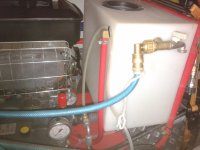Think about it, you are running 4gpm, if you let go of the trigger your pump is still pumping 4gpm but either back to the buffer tank, circulating back through the pump until you pull the trigger again or shut off the machine.
If you are bypassing 4gpm, a 10 gallon tank will be full in less than 3 minutes, when you let go of the trigger again, more water will go to the tank until it is over flowing and spilling on the ground. Sooner or later people will see liquid spilling onto the ground and wonder if that is water, some kind of chemical or is that normal or what?
I don't think you want to go and empty the small tank after you let go of the trigger every 5 or 10 times or have water spill on the ground.
You could put a longer bypass hose from the unloader to the inlet so the water does not heat up as fast but as long as you have water circulating back into the pump, it will get warm then hot eventually.
I am sure it gets old shutting down the machine every once in a while so that the pump has cool water going through it.
You could put a small buffer tank like 50 gallons with a hudson float valve so it does not over fill from the supply hose and then you can run your bypass from the unloader to that tank and you can bypass for a while and not get warm or hot water into the pump this way. 50 gallons of water will weigh about 417 pounds when full but I don't think you will haul a full tank of water around. You could also install a second float valve and have it at the 1/2 full mark so when you are about to finish working, switch over to that float valve so the tank will never fill more than 1/2 full and when you are done working, the most you will have will only be about 25 gallons in that tank.
If your machine will not pull from a tank (a lot of machines will not pull from a tank) then this will not work for you.
Just some ideas for you to think about.


